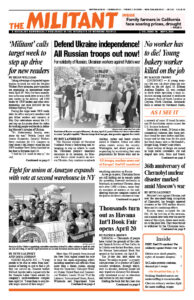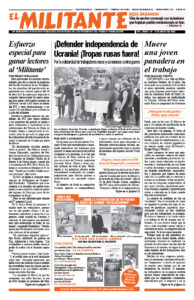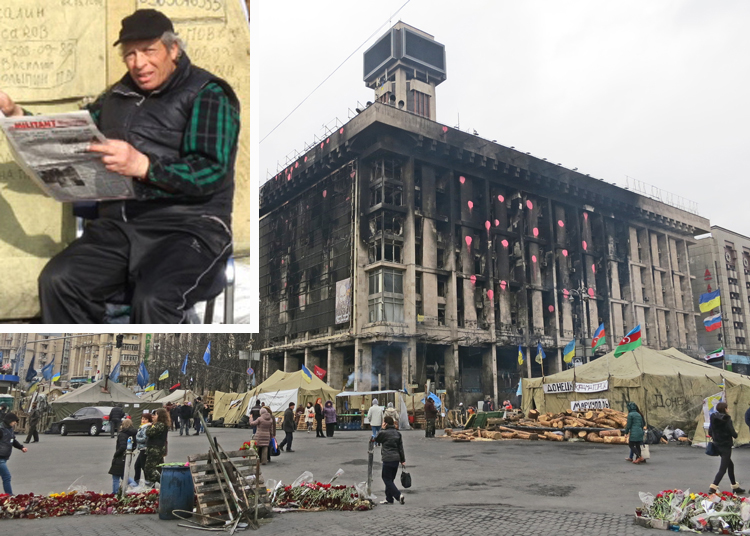Refusing to surrender to Moscow’s invasion, Ukrainians are fighting to defend their country’s independence and courageously protesting when their villages and towns are occupied, as the regime of Russian President Vladimir Putin attempts to subjugate them and crush their country.
Their determination draws strength from what was accomplished in 2013-14, when millions of workers, farmers and young people took to the streets for months in the face of thugs, cops and armed assaults that killed dozens, and toppled the Moscow-backed regime of President Viktor Yanukovych.
The Socialist Workers Party responded to that popular uprising by sending three Militant reporting teams to learn about these battles from the fighters involved and to get out the truth about the Maidan uprising, named after the central square in the Ukrainian capital, Kyiv. Protesters occupied it, setting up tents and barricades.
Militant editor John Studer and other team members met with coal miners, nuclear workers at Chernobyl and Enerhodar, rail workers and many other defenders of Ukrainian sovereignty, from Sokal in the west to Pavlograd in the east, to iron-ore miners in Kryvyi Rih, and the cities Dnipro to Kharkiv.
As a result, the Militant led in getting out the truth and defending the battle for Ukrainian independence, and reporting struggles by the country’s working people for their own class interests.
It gave the lie to the Putin regime’s claim that the Maidan was a U.S.-manipulated fascist uprising, echoed by much of the middle-class left. It was a working-class upsurge.
“My soul is with the people in the Maidan,” coal miner Yura Sheremeta in Chervonograd, western Ukraine, told the Militant reporters in April 2014. When Moscow seized the Crimean Peninsula from Ukraine, Sheremeta said he was inspired by the resistance to the occupation by Crimean Tatars.
“We are a sovereign nation,” he said. “We have spirit and we will continue to fight. If we don’t succeed this time, we will have another Maidan. And I think there will be one in Russia too.”
Militant reporters interviewed Mustafa Dzhemilev, the central leader of the Crimean Tartars people, who was expelled from Crimea after Moscow occupied it. They interviewed leaders of Jewish organizations about the slaughter of Jews by Nazi forces at Babyn Yar during the second imperialist world war.
Protests began in 2013 after Yanukovych abandoned a planned trade deal with the European Union, under pressure from the Russian government. These largely student protests “were met with truncheons and bullets,” Mikhailo Volynets, president of the Confederation of Free Trade Unions, told the Militant. “The unions and the workers joined and tens of thousands turned out. Only then did these politicians show up and build careers and power out of it.”
Pitched street battles were fought in the Maidan by working people and youth — including both Ukrainian- and Russian-speakers side by side — against the regime’s thugs. Yanukovych unleashed the Berkut, the regime’s notorious riot cops, who opened fire, killing scores.
During the Militant team’s first visit, just days after Yanukovych fled, Feb. 22, 2014, tents were still up with thousands of combatants remaining there. They were determined their victory wouldn’t be overturned by a new gang of politicians. The team did run into rightists — members of the Right Sector and others — but they were a distinct minority. They visited tents set up by coal miners from Donetsk; union journalists; a number of units who organized the defense of the Maidan, including leaders of a Jewish unit; artists; Crimean Tatars; and many more, eager to talk to the paper and tell their story.
Opposition parties had tried to get working people off the streets to bolster the regime before Yanukovych left, fearing a social revolution. They cooked up a deal with governments of Russia, Poland, France and Germany where Yanukovych would remain in office, relinquish some powers, and elections would take place many months later. When they took this plan to thousands occupying the Maidan they met a unanimous chorus of boos.
“No Yanukovych is going to be president for a whole year,” Volodymyr Parasiuk told the crowd. He captained one of the key defense units that held the square. “Tomorrow by 10 o’clock he has to be gone,” he said to a roar of approval.
That night Yanukovych fled under cover of darkness. Asked by reporters when protesters would take down their barricades, Parasiuk said, “We are not going away.” Five days later the interim government announced it was disbanding the Berkut.
Workers’ confidence grows
“Workers are beginning to see that they are actors in history,” Alexei Oleksyevych, a leader of the Independent Trade Union of Miners, told the Militant in Dnepropetrovsk in the mainly Russian-speaking eastern Ukraine in March 2014. He helped organize rallies there in solidarity with the Maidan, drawing workers from area plants and youth. The Militant team toured some of the factories and talked to workers about what they had done. “We brought down the Yanukovych regime and are making gains against bosses in our plants and mines because the power of the Maidan, and Maidans across the country,” Oleksyevych said.
In response to Yanukovych’s fall, Russian government troops stationed in Crimea under an earlier agreement with the Ukrainian government seized the peninsula and orchestrated attacks on Ukrainian government forces by pro-Moscow separatists in eastern Ukraine.
“Many of us have relatives in Russia and have long considered Russians as our brothers,” Samoilov Juriy Petrovych, the leader of the Independent Trade Union of Miners in Kryvyi Rih, told the Militant at the union’s headquarters. He led Studer and the others on a tour of the biggest iron-ore mine there. “But today the Russian government is threatening an invasion of Ukraine, and the majority of workers here agree that we will do our best to defend our country.”
He explained how the union joined in organizing Maidan protests in the city that were attacked by local cops and thugs that drew on guards from the mine. The unionists organized self-defense units and beat them back.
Militant reporters were invited to visit Chernobyl by the ATOM Trade Union, which organizes nuclear workers in Ukraine and still has hundreds of members working at the now disabled plant there that exploded in 1986. They were invited to join in the annual festival celebrating the founding of Slavutych, the city erected after the Chernobyl disaster shuttered their former homes in the now uninhabitable town of Pripyat.
“The parade and festival are much bigger this year, and more spirited,” Sergey Akamovych, a member of the union’s central committee, told Studer June 8, 2014, at the celebration. “More workers from the Chernobyl nuclear plant, like me, are wearing traditional Ukrainian shirts or carrying Ukrainian flags.”
The reason, he said, was the victory of “the big events in the Maidan. Ukrainians are more conscious, more self-confident.
“They need to be. There are people from 49 nationalities here, from Russia, Donetsk, Lviv, all over Ukraine,” he said. “By challenging our country, Putin has brought us together in defense of Ukraine. Things won’t ever be the same.”
The victory of the Maidan uprising succeeded in getting the Yanukovych regime off the backs of working people. But the Ukrainian working class didn’t yet have a party of its own that could lead it and its allies to replace capitalist rule with a workers and farmers government. Over time, the tents came down on the Maidan.
Class-struggle battles over wages and conditions have erupted periodically in the mines, mills and factories and on the railroads in the years since, as the capitalist rulers have pressed to boost profits and pay off loans to the International Monetary Fund. The determination of working people in Ukraine to defend its independence was deepened, and exploded again in mass resistance to Putin’s invasion this February.


